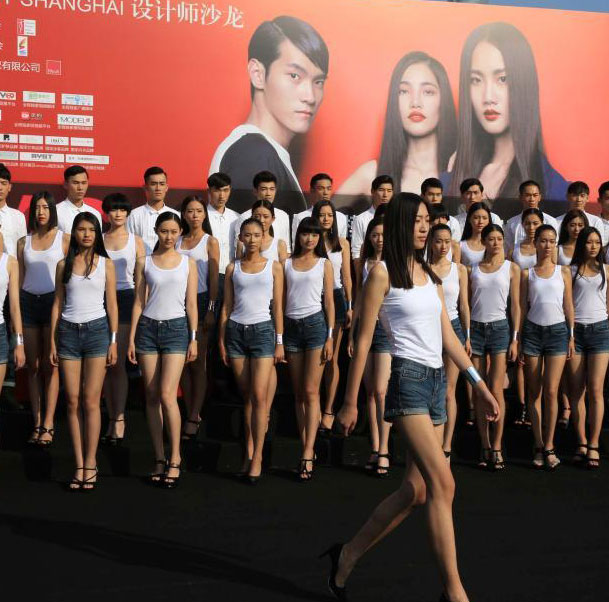 Get off at the last stop — Beijing Subway in vision
Get off at the last stop — Beijing Subway in vision
 Top 100 beauties in the world!
Top 100 beauties in the world!
 Gallery: Who is the most beautiful one?
Gallery: Who is the most beautiful one?
 If you like autumn, put your hands in the air!
If you like autumn, put your hands in the air!
 Fan Bingbing's "Queen style" in new play
Fan Bingbing's "Queen style" in new play
 Lingerie show at 2014 Miss China
Lingerie show at 2014 Miss China
 J-10 fighters show aerobatic stunts in smog-free sky
J-10 fighters show aerobatic stunts in smog-free sky
 Charming contestants of Shanghai Int’l Model Contest
Charming contestants of Shanghai Int’l Model Contest
 Most amazing chi-pao beauties
Most amazing chi-pao beauties
 7 deadly animal attacks
7 deadly animal attacks
RIO DE JANEIRO, Dec. 2 (Xinhua) -- Two of the world's largest scale and most multifaceted events - the 2016 Olympic and Paralympic Games -- are coming to Rio de Janeiro in less than two years.
Rio 2016 procurement director Fernando Cotrim is responsible for developing the organizing committee's supply chain. The mission includes ensuring that 30 million items are available, from ballpoint pens to sports equipment, furniture, horse food and even ships, a variety of articles unparalleled in scale.
The operation includes more than 60 thousand square meters of storage space - divided between the Barra, Deodoro and Maracana zones - and more than 1,000 outsourced professionals.
Cotrim faces the greatest challenge of his career and is welcoming cooperation from Chinese companies.
The official mascots of the games -- a bright yellow cat-like character for the Olympics and a mop-headed doll for the Paralympics -- were unveiled on Nov 24. A company from China is the licensed manufacturer and vendor for both mascots, as well as the official pins for the games.
Last month, a Chinese sports apparel maker became the official uniform supplier for the games, agreeing to provide more than 106,500 uniforms to technical staff, volunteers, test event personnel and torch relay participants.
"Two Chinese companies have been included in the supply chain for the games. One is 361 Degrees for the uniforms and the other is Honav for the production and sales of pins and mascots," Cotrim told Xinhua in an exclusive interview recently.
"As far as I know, in other bidding process like furniture, there are also Chinese companies eager to be part of the supply chain," he added.
Cotrim said that about 80 percent of the supply chain would be negotiated in 2014 and 2015.
"We'll establish product and service catalogues and we'll do the last-minute adjustments to our logistics before it becomes operational. Between 2015 and 2016, we'll focus our efforts on managing supplier contracts as well as the logistics chain to ensure that everything goes according to plan," he said.
As China hosted the 2008 Beijing Olympic and Paralympic Games, many Chinese companies with Olympic experience are keen to take part in the Rio games.
Cotrim said he hoped that after experiencing the Beijing Olympics, Chinese companies could understand the bidding process of the Rio games supply chain and become actively involved.
In 2013, Rio's supply chain team made a special trip to China to discuss the procurement schedule of all materials and services needed. In addition, according to the Chinese Embassy in Brazil, some Chinese companies also came to Rio looking for deals during the preparation stage.
Cotrim said the games would be a boon to Chinese companies exploring overseas markets.
"I heard that 361 Degrees is going to enter the Brazilian market through the promotion of the Rio Olympic Games," Cotrim said. "I believe their brand will prosper not only in Brazil, but in the whole of Latin America."
Cotrim said that some Chinese companies have chosen to join the supply chain by cooperating with their European and American counterparts. He suggested that Chinese companies that want to participate should not only study the legal and tax environment, but also understand the operational mechanisms of the local market.p "Only if you have an in-depth understanding of the local market and know how the market runs, can you effectively avoid the risks and reap the benefits," said Cotrim.
The cartoon-like mascots and the official uniform are also big business.
Organizers hope that Olympic merchandise, much of it carrying the mascot logo, will generate sales of 1 billion reals ($400 million). The organizing committee will receive about 15-20 percent of the sales of branded merchandise, with the rest going to licensed manufacturers and vendors.
 HK majority will decide fate of protests
HK majority will decide fate of protests Guangdong officials rob graves to meet monthly cremation targets
Guangdong officials rob graves to meet monthly cremation targets A home for all seasons
A home for all seasons GT Leader Round Table discusses reform and growth
GT Leader Round Table discusses reform and growthDay|Week|Month